Walls and floors
Landscaping with native plants
When creating an outdoor space that’s as easy to live in as it is easy on the eye, we need plants that are both practical and pretty. It’s no coincidence that native plants are highly rated among garden designers.
Native plants offer some our most attractive landscape solutions, providing excellent shelter, quick privacy and easy care groundcovers. They have a magic way of enhancing each other in all-native plantings and they work beautifully with exotic plants too.
Native floors
Once the all important driveways, paths and patios are in place, the spaces left for planting are open to an exciting range of options. Lawns are not the only way to cover our outdoor floors. The best groundcovers beautify while also cutting down on maintenance.
They can soften the edges of pathways and retaining walls, jazz up shady ground under trees, and fill vacant spaces under and around shrubs, leaving no gaps for weeds to grow. As well as interesting foliage, many groundcovers bring seasonal interest with a display of flowers or berries.
Groundcovers also play an important role in soil conservation. A bare soil that’s exposed to wind, sun, rain, hail or snow is damaged over time. Wind can blow topsoil away. Excessive rainfall and a sloping site will conspire to create the worst kind of erosion. Temperature extremes are not good for the soil either. A fully clothed ground surface is best.
Important: Eliminate all weeds before planting groundcovers. Persistent perennial weeds like oxalis and invasive grasses will push their way through and, once entangled, can be impossible to remove without clearing the ground and starting all over again. Spraying with weed killer such as glysophate (usually twice) is the best way to ensure a clean slate.
Top NZ groundcovers:
The small leafed, ground hugging coprosmas are among the best for covering large areas of ground. These low mounding shrubs offer a wide range of colours and textures. For example, we have bright green ‘Kirkii’ or Coprosma neglecta, green and white ‘Kiwi Silver’, darkest green ‘Black Cloud’, gold-orange ‘Autumn Haze’ and red-brown ‘Red Rocks’, which forms a tangling mass of springy branches – great for textural contrast.
Also great for covering large areas, Creeping pohuehue, Muehlenbeckia axillaris, is a vigorous creeping shrub that can be grown either as groundcover or over a fence as a vertical screen. It forms a thicket of small dark green leaves. Best in sun, it is both wind and dry tolerant, and useful for covering dry banks.
Ideal for sandy coastal gardens, Fuchsia procumbens is a pretty trailer producing a mass of soft green leaves and exquisite little yellow flowers with a burgundy splotch, prominent red stamens and blue pollen. Red berries follow flowering. It will grow in sun or light shade but needs protection from frost.
Panakenake, Pratia angulata, loves damp soil. Masses of white flowers cover the tiny leaves in summer, with pink berries in autumn. But watch out – it can take over if you let it. Wind hardy, frost hardy, dry hardy, sun or shade hardy, Blechnum penna-marina is a tough little fern that makes a dense cover 10-30cm tall. In shade it is taller. In sun the new growth has a beautiful pink hue.
Leptinella minor is beautiful in association with stepping stones or as a low traffic lawn substitute for low traffic areas, producing a thick creeping carpet of tightly packed fern-like leaves. However it needs very well drained soil that doesn’t dry out in summer. As well as the green species and there is ‘Platt’s Black’.
A favourite for colour contrast, Acaena inermis ‘Purpurea’ forms a low, ground creeping carpet of rich burgundy foliage that works beautifully with green plants. Also great for colour are the NZ geraniums. The Chatham Island geranium (Geranium traversii) has given rise to in a range of garden cultivars with very attractive foliage colours, including ‘Pink Spice’, ‘Thunder Cloud’ and ‘Purple Passion’. These popular perennials have attractive frilly rounded leaves and dainty pink flowers. Suitable for sun or semi-shade, they make lovely a lovely border and are well suited to pots.
Libertias (NZ Iris) are loved for their colourful leaves, strong vertical accent, attractive flowers and berries. Libertia perigrinans has stiff orange foliage which spreads via underground rhizomes and can overpower other plants, but it’s great where there is space. Other Libertias are more restrained. ‘Taupo Blaze’ changes from green in summer through to orange then red in winter. Good as an accent to carpet plants such as Acaema ‘Purpurea’, Scleranthus or Geranium ‘Thundercloud’.
The perennial Raoulia hookeri is one of the few alpine plants that can be grown with relative ease in a garden situation, although it must have excellent drainage. Its unique silver mat is dotted with tiny yellow daisies in summer.
Scleranthus, New Zealand’s sun loving ‘moss plants’ form smooth brilliant-green carpets that look great with rocks, grasses and other groundcovers. They must have full sun and well-drained soil. Brown patches may occur, usually if the soil becomes too dry. These can be cut out and ‘patched with rooted pieces taken from the side of the plant. Of the different species, Scleranthus uniflorus is the brighter green and has the most compact growth habit.
Native walls
Backyard seclusion is a high priority for most of us and it’s no surprise that properties with well-planted, private back yards have higher values.
The right kind of planting also provides effective shelter from chilling winds. On a windy site a thick living screen makes a far more effective buffer to wind, dust and salt spray, than an impervious solid wall. Established shelter trees will provide protection for a distance of up to ten times their height.
When privacy is on the wish list, we naturally want our trees to grow as quickly as possible. However, the fastest growing varieties generally require the most frequent trimming. The actual growth rate for any tree depends to a large extent on soil and climate, but to achieve the fastest possible growth rate, we can make sure we plant in well-drained soil with compost. Mulch to preserve moisture (but don’t pile it up against the plants), use windbreak fabric to shelter young trees, and water during dry periods. Take care not to overdo feeding or watering, however, most native plants don’t like soil that is too wet and they can be sensitive to excessive fertiliser.
A formal clipped hedge is a thing of beauty, but it also requires regular attention. Informal screens and shelter plantings are not so demanding and just as effective. If you choose plants that naturally grow within your desired height range, all that is required is an occasional trim to maintain a thick bushy cover at the desired height. When left untrimmed many natives provide the added bonus of flowers or berries, giving colour and interest while providing food for wildlife.
When there is enough space to go wider than single file, a mixture of trees and shrubs makes an attractive, low maintenance screen, and is a great habitat for native birds.
Favourites for screens and hedges
With fine foliage that’s perfect for clipping, corokias rate among New Zealand’s favourite hedge plants. They are frost hardy and relatively quick growing. A range of very attractive cultivars offers a wide choice of colours; grey, bronze, olive green, reds and golds. If left untrimmed they will produce flowers and colourful winter berries, which attract native birds.
Pittosporums bring privacy an established feel to the garden within two or three growing seasons. Pittosporum tenuifolium (Kohuhu) is quick growing with attractive small leaves that are great for picking, especially if you plant one of the colourful cultivars. These are generally smaller growing than the wild form, better for town-sized gardens. Ideal for coastal gardens is Pittosporum crassifolium (Karo) with thick pohutukawa-like leaves. Another excellent pittosporum to use as hedging topiary or background planting is 'Stephen's Island'.
Shiny leafed kapuka, Griselinia littoralis, with its leather wavy edged leaves is a favourite for hedges at any height. The cultivar ‘Broadway Mint’ is a slightly greener version of the original species. ‘Whenuapai’ has a dense, narrow growth habit. ‘Twilight’ has darker stems and mid green leaves. Griselinia will cope with a light frost once established but is at its best in coastal gardens.
New Zealand’s Olearia species offer a huge range of different leaf forms. These large windy hardy shrubs produce daisy flowers – some small and insignificant, others very showy. There is an Olearia to suit almost every climate. Among the best for quick screening are narrow leafed Olearia lineata, and Olearia ‘Dartonii’. Wavy leafed Olearia albida (tanguru) is quick growing and excellent for shelter or hedging plant in coastal gardens. Similar looking Olearia paniculata is a favourite South Island hedge.
Lophomyrtus (syn. Myrtus) 'Burgundy Red' Lophomyrtus ‘Kathryn’ and the more compact Lophomyrtus ‘Red Dragon’ are excellent choices for those looking for a colourful hedge. They’re loved for their crinkly leaves that emerge bright pinky red and intensify as the weather cools. Dwarf form ‘Pixie’ (30cm tall) is great for low hedges or pots.
Horopito, Pseudowintera colorata, is too slow growing if you are impatient for screening, but as a shrub for year round colour contrast it is one of the best, with dense olive green leaves mottled gold and red. The peppery leaves are used in Maori cuisine. The smaller growing cultivar 'Red Leopard’ is ideal for smaller gardens or containers, or as a stunning little hedge.
At their best in a mixed planting, the colourful Leptospermum cultivars put on a showy display of pink white or red flowers in spring. For early spring flowering and the birds they bring, it’s hard to resist the kowhais (Sophora) and nor should you, because there are cultivars to fit any size of garden.
When space is tight growing a climbing plant over a fence is a good way to create a green screen without sacrificing too much ground space. Spectacular Clematis paniculata (puawhanganga) is a fast growing evergreen with masses of white flowers in spring. In a frost-free location, Tecomanthe speciosa makes a handsome cover for a strongly built structure with soft green flowers that Tui love.
Tip: When the boundary fence isn’t tall enough, placing a screen closer to the sitting area will block a higher line of sight and provide greater privacy. Internal screens may be taller than the usual 1.8m allowed for a property boundary.
Success with native plants
- Choose plants that are suitable for your climate and soil type.
- Most natives need well-drained soil. On heavy soils or wet sites, assist drainage by planting on slopes, raised mounds or in planter beds.
- Once established, most natives thrive without fertiliser, but a little blood and bone or controlled release fertiliser at planting time provides a strong healthy start.
- Apply compost in spring, summer or autumn.
19-Aug-2015
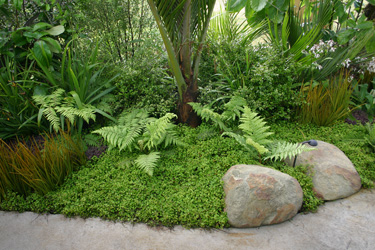
Fuchsia procumbens makes a lush carpet beneath Nikau Palms
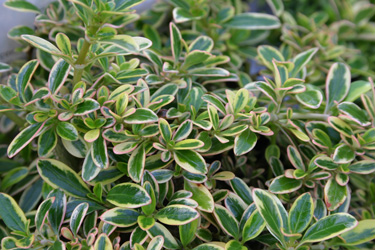
Coprosma 'Kiwi Silver'
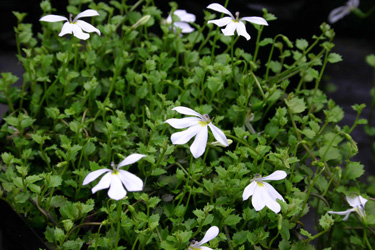
Pratia angulata
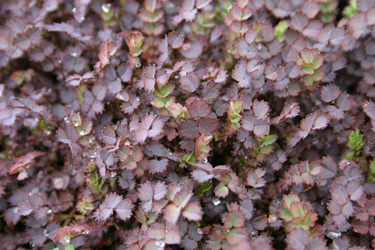
Acaena inermis 'Purpurea'

Corokia 'Tutti Frutti'
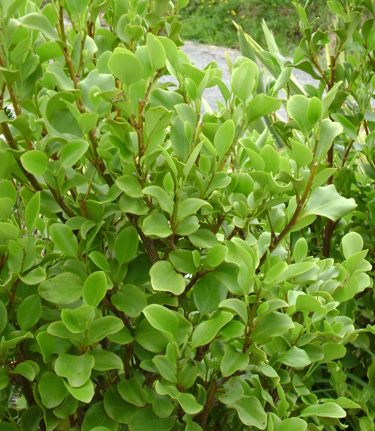
Griselinea littoralis
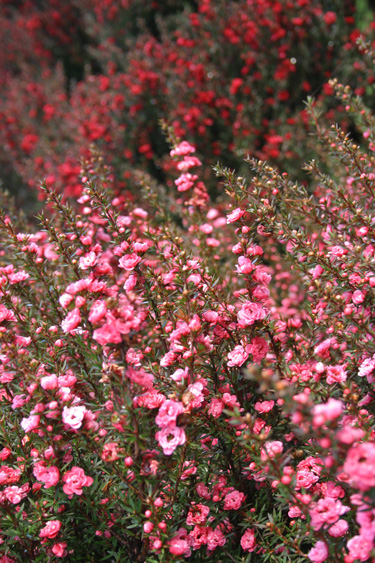
Leptospermum cultivars
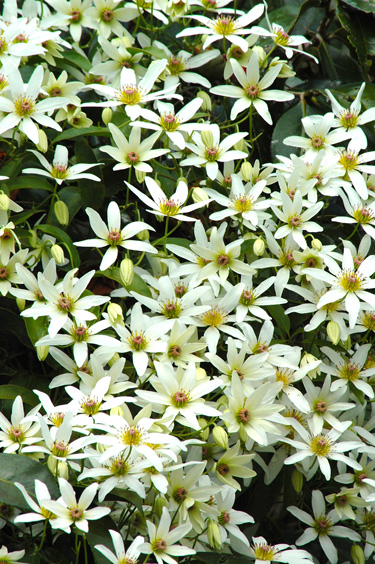
Clematis paniculata


